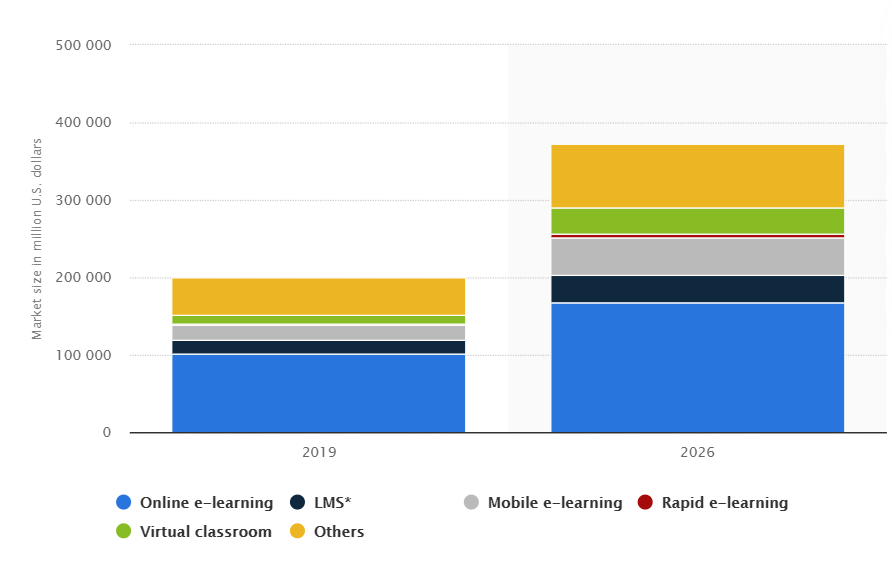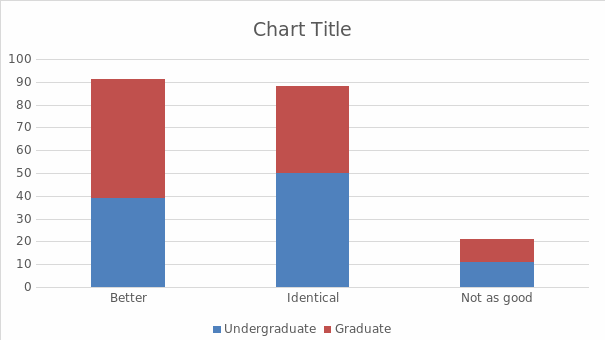Executive Summary
Online learning has greatly evolved within the aftermath of the COVID-19 pandemic. Having transformed from an optional addition to the general educational process to the necessity to all the pupils, the commercial side of the e-learning has rapidly increased its market share. E-learning has been established as a profitable business model in the United States before the strike of the pandemic, yet its three main subtypes have proven to be redundant.
The existing approach of the regular tutoring arrangements re-positioned online wasn’t enough to cover the expanding market needs. Its alternative, the high-profile high-budget digital learning courses reliant on the latest technological innovation remained inaccessible for the majority of the exploding market. Due to its production costs and luxury pricing strategy, tied with the reputation of the universities producing the digital educational content, the production teams possessed an extremely limited flexibility.
The subscription-based educational content services definitely present a well-established niche within the industry, yet have difficulties in attracting lower middle class and working class clients. This is to do with the way a subscription-based business model leads to a client frequently paying for the content they are not in need of in addition to the content that has attracted them to the service.
An American online learning platform Outschool is an illustrative and effective example of the business model that provides a solution to the aforementioned inefficiencies. Outschool markets its online classes as separate products, that can be purchased by their customers individually depending on their needs. The courses are reasonably priced in accordance with their factual value, with those for primary school-aged pupils costing significantly less then those of a university level. Individual approach to every class, in contrast with the subscription-based model, enables the high degree of customization both in topics and in tools. Outschool is an overall effective and innovative response to the demands of its time, beneficial to both the pupils and their parents.
Introduction
COVID-19 affecting the commercial and social processes worldwide, a variety of most important services have fundamentally transformed. New constraints and regulations imposed to slow down the spread of the virus restructured the ways in which people attempt to satisfy their general needs. Extremely stressful at first, e-learning techniques have deprived the pupils of many of the school facilities, initially limiting the efficiency of their studies. However, the change of circumstances for the education system worldwide lead to the expansion of the market niche for online classes and tutoring services.
The American online learning platform Outschool is an illustrative example on a firm that has adapted its product to best serve the evolution of demand. It provides a wide variety of video lessons presented by experts in their fields, that a customer might buy separately, without paying for a potentially redundant subscription. This paper discusses the unique features of its products and its selling point by examining the previous approaches to the online learning industry and comparing them to Outschool.
Previous Approaches
The online learning business model has always been a largely difficult one to monetize, as it relies on marketing a product, a version of which the majority of the customers are able to obtain for free. In combination with the academic article piracy tools and ability to exchange assignment solutions via chats and forums, modern students have the capacity to use and abuse the online space in their studies. However, the resulting sphere often has more in common with academic cheating, then the online learning itself. Naturally, it does not constitute the valuable, marketable and legitimate product that a well-known brand, partnered with schools and universities, can be expanded upon.
It is important to specify, that the e-learning market in the United States has existed since the second half of the XX century, but lacked a transformative impulse for a considerable time. The diagram below indicates the estimated growth of the e-learning industry, accounting for the pandemic impact:

COVID-19 pandemic was chosen as a focal point that separated the two eras in the e-learning, as it marked the industry’s transformation from and option into a necessity (Azorín, 2020). The previous approaches to the e-learning business model and its profitability can be classified into three groups. These groups include the additional tutoring sessions marketed to struggling students, the interactive, high-profile online courses, and the subscription-based academical content services. As lessons and lectures were generally presented worldwide, it operated and functioned primarily as an add-on, an extra academic help for students who were struggling with certain class topics.
Parents of the students or the students themselves were paying the agreed rate to an expert in the required field, usually a teacher or an older accomplished student, in exchange for private lessons. In this case, Internet was a means to an end, often incorporated to address the transportation barriers or timetable constraints (Hrastinski et al, 2016). The online part of this form of online learning was a tool, designed to increase the marketability of the tutoring service in general, and did not provide much innovation to the business model it used.
The second type includes highly innovative online courses, often designed and provided by the higher education institutions. Their target audience involves the offline students of said institutions, with the production budget for the product being largely sourced from the target audience’s admission fees. Pupils have indicated great levels of satisfaction with their classes, with up to 52% of graduate students commenting on the online learning surpassing the in-classroom education. The graph below visualizes the findings of said survey in the form of a bar chart:

However, the production of such interactive long-term courses is an extensive investment, sometimes summing up to a total of $1.5 million (Dumofrd & Miller, 2018). These resources get directed to the development and optimization of a required platform, as well as the programming of exercises and expert partnership costs.
Consecutively, the executives behind the production of such materials struggle to lower its accessibility barrier. Instead, they opt out for the luxury pricing strategy, emphasizing the quality and exclusivity to those who are willing to pay. And with the evolution of the market within the last two years, it has become evident that the second existing approach does not satisfy the current needs of the customers.
Finally, the subscription-based academic content services, such as Skillshare and Thinkfic, have definitely found their niche in the online educational content market. Prior to the worldwide boom of the e-learning, they have invested into the diversification of the provided educational resources, covering not only academic, but creative skills in their video lessons. The main downside of such services is an inherent attribute of the subscription model itself.
Not every customer in need of an online learning support is willing or able to pay a rate that factors in the services they would never plan to use. Most of the subscription-based services, including the mentioned examples, have not yet perfected the diversification and customization of its subscription plans (Tarkar, 2020). This is largely to do with the profitability concerns, as otherwise the financial return on less popular classes could have dramatically decrease. Additionally, some commentators have gone so far as to claim the exploitative element of the subscription-based model, as it has been accused on capitalizing on the human forgetfulness.
New Findings
Outschool provides a fresh, effective, personalized solution to the aforementioned problems in the midst of the global crisis of the education industry. The platform’s users take advantage of the digital form of the classes, with specifically designed programs and mini-games being incorporated into lessons to increase engagement and diversify the information delivery (Palvia et al, 2018). Thus, the platform utilizes the unique opportunities of the online sphere, instead of simply delivering the nearly unchanged lessons through the Internet. The price for each class, although different, is affordable and paid by a customer on a one-time basis, without losing an access to a purchased lesson in any point in the future (Peng, 2020).
Every customer has the opportunity to discuss the potential purchase with a platform’s customer support adviser before making a decision, reducing the risks of paying for a good one does not really need. The firm has been successful in attracting and holding the attention of its target customers, with the majority of them being parents of the children who are currently at school. The graph below illustrates age distribution for the consumer demographic of the Outschool.

The platform ensures its material is delivered by qualified professionals by designing and maintaining a strict verification procedure. A candidate that wishes to become the services’ professional is required to present their teaching qualifications and disclose personal information on themselves to check their eligibility to work with children. After successfully passing the verification, however, each teacher is treated as the member of the united team with shared goals and interests. The platform is notorious for its warm treatment of employees, which does not come as a surprise considering their professional qualities are in the core of the firm’s product.
In its assortment, Outschool puts an emphasis on the subjects that a pupil is likely to encounter at school, including languages, natural sciences and maths. However, in delivering the classes, the experts often take use of the somewhat unconventional approaches to engage the students and better get their point across. The unusual tools in question include Dungeons and Dragons mechanics applied to the statistics classes, as well as the Minecraft programming lessons.
Conclusion
In conclusion, Outlook represents a new generation for the online learning both in the United States and worldwide. Its focus on the one-time purchasing of the selected courses as opposed to the subscription business model is an attractive feature that aids in attracting the customers from lower soicio-economic backgrounds. The company ensures the high quality standards for its content and markets itself as an engaging yet helpful academic tool that allows parents to feel secure in their children’s education.
With the continuous emergence of the new strengths of the virus, and the initial adaptation period to the compulsory online learning being in the past, it is likely that, for better and for worse, the e-learning market will continue blooming. By diversifying their content and the ways in which this content can be accessed, the online learning companies throughout the country can maximize their revenue and increase the lesson quality. At the moment, however, Outschool remains perhaps the most effective firm in the industry due to its individual approach, innovative digital tools and mass-market pricing.
References
50 Online Education Statistics: 2020/2021 Data on Higher Learning & Corporate Training « Guide 2 Research. Guide2research. (2021). Web.
Azorín, C. (2020). Beyond COVID-19 supernova. Is another education coming?. Journal Of Professional Capital And Community, 5(3/4), 381-390. Web.
Dumford, A., & Miller, A. (2018). Online learning in higher education: exploring advantages and disadvantages for engagement. Journal Of Computing In Higher Education, 30(3), 452-465. Web.
E-learning: global market size by segment | Statista. (2021). Web.
Hrastinski, S., Cleveland-Innes, M., & Stenbom, S. (2016). Tutoring online tutors: Using digital badges to encourage the development of online tutoring skills. British Journal Of Educational Technology, 49(1), 127-136. Web.
Palvia, S., Aeron, P., Gupta, P., Mahapatra, D., Parida, R., Rosner, R., & Sindhi, S. (2018). Online Education: Worldwide Status, Challenges, Trends, and Implications. Journal Of Global Information Technology Management, 21(4), 233-241. Web.
Peng, J. (2020). An Analysis of Online Education Business Model. Proceedings Of The International Conference On Education Studies: Experience And Innovation (ICESEI 2020). Web.
Tarkar, P. (2020). Impact of COVID-19 pandemic on education system. International Journal of Advanced Science and Technology, 29(9s), 3812-3814. Web.
TechCrunch is now a part of Verizon Media. Techcrunch. (2021). Web.
